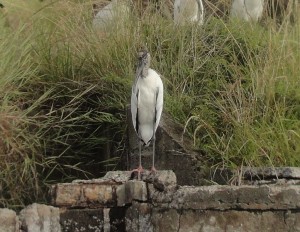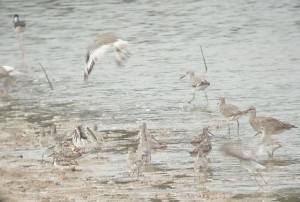The mountainous country of Costa Rica is better known for its wealth of hummingbirds, highland endemics shared with Panama, and rainforest species rather than shorebirds but waders certainly do find their way to this double-coasted land. In fact, Costa Rica has a very healthy list of plovers and sandpipers, many of which can be seen at the shorebird hotspot known as Chomes.
This mosaic of shrimp ponds on the Gulf of Nicoya is one of Costa Rica’s best known sites for waders and has turned up a bunch of rarities over the years. If it were scrutinized as often as national parks and reserves in the United States, Britain, and elsewhere, I bet it would produce more vagrant shorebirds than we are aware of and maybe even a new bird or two for the country. Although some birders make it to Chomes, given that visits are far and few between and the tendency for shorebirds to leave a site almost as soon as they arrive, I can’t help but wonder about the birds that hang out in those hot shrimp ponds when no one is there to identify them. It would be a fantastic place to put up a few web cams, hides for bird photography, or train and pay locals to survey the birds. Until then, we will just have to encourage birders to visit the site as much as possible during fall migration.
Regarding surveys, it would be even better to perhaps kayak or sail around other parts of the Gulf of Nicoya to survey the many inaccessible sites with shorebird habitat. If you are boatless, though, Chomes can be visited and it usually produces results. Patchy dry forest on the way in can be good for a bunch of expected species and on Saturday, we found such niceties as Plain-breasted Ground-Dove (just one), Streak-backed Oriole, Orange-fronted Parakeets, and Crested Bobwhite perched on a post. We also had large numbers of Northern Rough-winged Swallows, a single female Purple Martin, Ferruginous Pygmy-owls, and rice fields that could hide a rail or two. Since this area has also turned up sweet species like Crane Hawk, Double-striped Thick-Knee, and even Aplomado Falcon, it’s worth it to keep your eyes and ears open on the drive in!
Rice field on the drive in. I bet there could be Spotted Rails in that human-made wetland.
It had a “Traill’s Flycatcher” that turned into a Willow with a “whit” call.
The shrimp ponds are on private land but so far, the people at the locked gate have been happy to open it for birders. There is also another road that leads to the beach and shrimp ponds but might not be so easy to find. Your best bet is asking locals for directions. Since water levels are regularly changed in the shrimp ponds, you may need to search a bit for the best shorebird habitat and will need a moderately high clearance vehicle to do so. This past Saturday, we were let in straight away and were psyched to connect with shorebird success at the first pond.
Wood Storks hung out in the back of the pond.
Roseate Spoonbills and White Ibis brightened up the place with their lovely looks.
Short-billed Dowitchers and Western Sandpipers were probing the muddy margins like mad as Least Sandpipers and Semipalmated Plovers ran around drier parts of the pool. Greater Yellowlegs were around but Lessers were absent.
Black-necked Stilts are one of the more common waders in Costa Rica.
After thoroughly looking over the birds in that first pool, we ventured further in to the complex to check a pool that held tons of birds the previous year. High water kept it pretty much bereft of birds but we still managed to whistle in a Northern Scrub Flycatcher in the short mangroves.
These short-billed guys are very much anti-pygmy-owl.
We proceeded in towards the beach and hit the shorebird mother lode in the last of the ponds. As Least, Royal, and Gull-billed Terns floated overhead, we scoped through hundreds of Short-billed Dowitchers, Western Sandpipers, Willets, Whimbrels, and Black-bellied, Semipalmated and Wilson’s Plovers. We also found two Sanderling and a bunch of Ruddy Turnstones but nothing more in terms of wader diversity. Noting that the next pond over appeared to have some birds, we walked along the berm and set up our scopes behind an abandoned shack. This pond had even more birds including Black Skimmers, one Common Tern, a single Sandwich Tern, at least 120 Marbled Godwits, a bunch of distant Greater Yellowlegs. There could certainly have been other bird species present because even though I scoped through them several times, most were sleeping and thus difficult to identify, not all of the birds were visible, and a bunch were too distant to effectively scrutinize.
There were a bunch of Wilson’s Plovers.
The view from the shack.
Shorebirds in action.
Sleeping godwits, Whimbrel, Willets, Short-billed Dowitchers, and Black-bellied Plovers.
Marbled Godwit and Willets.
It’s one of those spots I wish I could check every day but since it’s a two and a half hour drive from my house, I usually get there just once a year. At least that annual visit is a birdy one!













4 replies on “Watching Shorebirds in Chomes when Birding Costa Rica”
Hi Patrick! While I was living in Monteverde I visited Chomes almost once a month for two years. Robert and a few other monteverdians regularly joined me. We visited the area only early morning/high tide to avoid the Chomes very high temperatures and get the high tide bigger resting flocks. Usually left the area around 9:30am. That means we had to leave Mverde at 3:00AM but it was well the effort, the whole area is amazingly bird-rich, being one of my most loved birding spots in CRica.
Cheers,
Eduardo
@Hi Eduardo! That’s awesome that you got the chance to bird there on a regular basis. I didn’t know you guys went there so often. The first time I went was actually with you guys. Yeah, quite the early start. Hope you are catching some good migration in Spain my friend.
Pat
Hi Patrick and Eduardo,
Do you observe least terms between sept-March at the Chomes shrimp ponds?
Thanks!
Sandy
@Sandy- Not so much in the winter but yes in September.